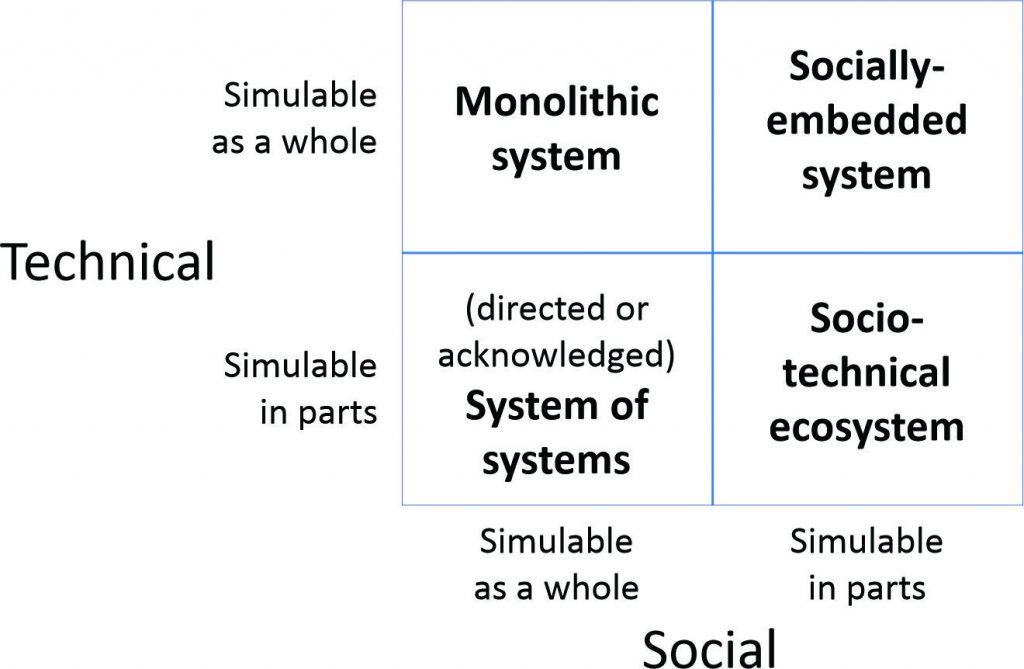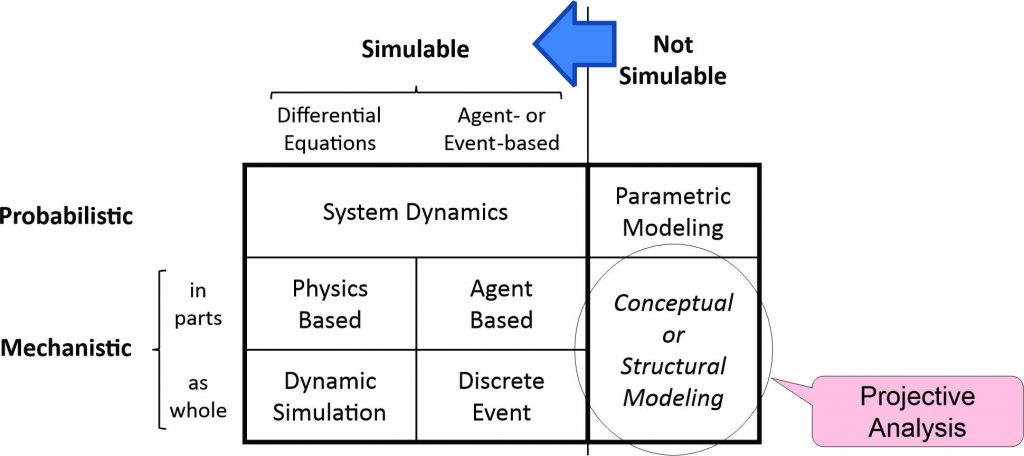by Philip Boxer
Ecosystems contain large numbers of operationally and managerially independent organizations interacting with each other in supplying and purchasing roles. These ecosystems present challenges summarized as follows:
- The causal models governing each supplier’s and customer’s behavior cannot be assumed to be stable over time;
- As the numbers of the supply-demand relationships within the ecosystem increase, the indirect demands on a supplier due to the demand situations facing its indirect customers become increasingly important in shaping the supplier’s choices.
- A supplier’s ability to re-align existing capabilities to meet new indirect demands may be as important as the ability to develop and deploy new capabilities for meeting direct demands.
- Resolving the dependencies between such re-alignment and acquisition or development will in turn depend on how the supplier understands its place within the larger ecosystem.
These challenges limit the kind of modeling approach that can be used for describing and analyzing a supplier’s relationships within such an ecosystem.
What is meant by ‘modeling’
A model is a formal system of inference that stands in relation to an observed system-of-interest such that the inferential relations in the model commute with the observed relations in the system-of-interest. If these inferential relations can be simulated such that the simulated behaviors correspond to the observed behaviors of the observed system, then the system of inference can be said to describe the mechanism governing the observed system’s behavior, and the observed system can be said to be simulable i.e. a mechanism (Rosen 1991).

Figure 1: Modeling the mechanisms within a socio-technical systems-of-interest
Modeling the mechanisms governing the behavior of task systems within a supplier present familiar challenges to the engineer, whether as a single system (Bass, Clements, and Kazman 2008), or as a system of systems (Clements, Gagliardi, and Wood 2010). But in these cases, there is a presumption of a sovereign enterprise determining the way the task system is to be used, whether directly under the control of the supplier, or subject to a contractual framework spanning multiple suppliers. New challenges emerge when this assumption no longer holds because of some surrendering of sovereignty by suppliers to customers, rendering the mechanisms governing the behavior of their sentient systems necessarily non-deterministic. This distinguishes the particular modeling challenges presented by socio-technical ecosystems, requiring that both the chronos axis of succession and the kairos axis of timespan of discretion be modeled.
Difficulties in modeling socio-technical ecosystems
Two difficulties present themselves when modeling socio-technical ecosystems. The first of these relate to the suppliers and customers within them being open systems that can be open at three levels. Systems that are open in this way are anticipatory systems (Rosen 1985), having the ability to be self-organizing through the way they anticipate the effects of their behavior on their indirect customers (Prehofer and Bettstetter 2005). This makes it necessary to describe such systems in terms of their three levels of behavioral closure because of the third level being open to indirect customers’ value spaces.
This brings us to the difficulty in determining what aspects of the behavior within and between suppliers and customers is ordered, meaning that behavior can be described in terms of mechanisms. For the behavior of a supplier or customer to be ordered, it must be possible to observe causal relations in its observed behavior that commute with the inferential relations in the model of its behavior. Given their levels of openness, much of the behavior of a supplier or customer cannot be described in this way, and is observed to be unordered in the sense that there are no immediately apparent relationships between cause and effect (Snowden and Boone 2007).
Thus while there may be behaviors within an ecosystem that are ordered and simulable, its characteristics as a whole cannot be assumed to be. Before imposing order on parts of an ecosystem through design, the modeler therefore needs to be able to understand the context within which such mechanisms are to be placed.
Distinguishing projective analysis from other modeling approaches
In constructing a model, there is a tradeoff between the model’s level of disaggregated detail, needed to capture rich causal dependencies endogenously within the model, and the breadth of the model boundary (Rahmandad and Sterman 2008). Thus as the number of suppliers and/or customers within a model grows, so its emergent behaviors will increase, making it more difficult to relate the behavior of the model to its observed behavior (Ryan September 2006). Such difficulties cannot be avoided in modeling ecosystems because of their scale. The difficulties of modeling the organized complexity of these systems can be contrasted with other kinds of modeling as follows:

Figure 2: Contrasting different types of modeling approach (adapted from (Li 2005))
Thus mechanisms may be considered deterministic, so that calculus and differential equations become applicable (ordered simplicity in Figure 2), while statistical methods become necessary for dealing with the aggregates (unordered complexity in Figure 2). But in between we have the complex non-deterministic behaviors associated with the interactions between large numbers of operationally and managerially independent entities (ordered complexity in Figure 2 (Li 2005)). Ecosystems fall within this last space, even though individual systems within them may be modeled as mechanisms. The various modeling approaches associated with modeling these simulable systems can therefore be placed within their larger context as follows (Anderson et al. 2007):

Figure 3: Comparing different modeling approaches (adapted from (Anderson et al. 2007))
Given that the larger context of a supplier cannot be assumed to be ordered and simulable as a whole, we therefore have to start with the supplier in considering how these modeling approaches relate to ecosystems.
The supplier or customer starts by formulating hypotheses about cause-and-effect relationships, whether made about the ecosystem as a whole or in parts, the events of which can be represented along the chronos axis of succession. These hypotheses can then be tested using simulation methods, but the initial process of formulating these hypotheses starts with the supplier’s or customer’s perceptions of the structure-determining choices that can be made along kairos axes of discretion. This process is referred to as a process of projective analysis in which the modeler makes these hypotheses explicit by projecting them into the model. The process uses conceptual or structural modeling to represent the modeler’s hypotheses (Sowa 2000). Once represented, the modeler can then test the hypotheses in whole or in part through the use of simulation (represented in Figure 3 by the blue arrow), or use them as a basis for designing and developing new business architectures.
References
Anderson, Bill, Lisa Brownsword, David Fisher, Suzanne Garcia, and Philip Boxer. 2007. “Using Structural and Dynamic Modeling to Support Acquisition, Development, and Sustainable Deployment of Software-Intensive Systems.” In, 3-13. Pittsburgh: Carnegie Mellon University.
Bass, L., P. Clements, and R. Kazman. 2008. Software Architecture in Practice 2nd Edition (Addison-Wesley).
Boxer, P.J. 2012. The Architecture of Agility: Modeling the relation to Indirect Value within Ecosystems (Lambert Academic Publishing: Saarbrücken, Germany).
Clements, P., Mike Gagliardi, and Bill Wood. 2010. “A Quality-Attribute-based Approach for Evaluation of Software, System and System-of-System Architectures.” In. Pittsburgh: CMU/SEI-2010-TN-015 (in draft).
Li, Hong. 2005. ‘A holistic model of enterprise development’, BioTheory, 1.
Prehofer, Christian, and Christian Bettstetter. 2005. ‘Self-Organization in Communications Networks: Principles and Design Paradigms’, IEEE Communications Magazine: 78-85.
Rahmandad, Hazhir, and John Sterman. 2008. ‘Heterogeneity and Network Structure in the Dynamics of Diffusion: Comparing Agent-Based and Differential Equation Models’, Management Science, 54: 998-1014.
Rosen, R. 1985. Anticipatory Systems (Pergamon Press: New York).
———. 1991. Life Itself (Columbia University Press: New York).
Ryan, Alex. September 2006. “Emergence is coupled to scope, not level.” In.: http://arxiv.org/abs/nlin/0609011v1.
Snowden, D. J., and M.E. Boone. 2007. ‘A Leader’s Framework for Decision Making’, Harvard Business Review, November.
Sowa, John F. 2000. Knowledge Representation: Logical, Philosophical, and Computatinal Foundations (Brooks/Cole).